Comprehensive Financial Risk Management Analysis Project Report
VerifiedAdded on 2022/11/28
|31
|5885
|230
Report
AI Summary
This report provides a comprehensive financial risk management analysis, focusing on quantitative techniques such as Monte Carlo simulation and sensitivity analysis to assess project risks. It begins with an executive summary outlining the methodology, which involves using numerical values for probability and consequences to evaluate a project's financial health. The report establishes baseline budgets and explores various scenarios, including optimistic and pessimistic outcomes, to determine their impact on profitability. It delves into sensitivity analysis, identifying critical variables and their effects on project outcomes. The report also examines risk events, distinguishing between fixed and variable risks, and proposes contingency recommendations. Furthermore, it compares the baseline budget with organizational policies. Finally, the report utilizes event trees, fault trees, and influence diagrams to model and analyze potential risks, providing a detailed understanding of financial risks and their management. The analysis includes detailed calculations and comparisons of different project scenarios to assess potential profits and losses, and incorporates expert opinions and data to refine the risk assessment.
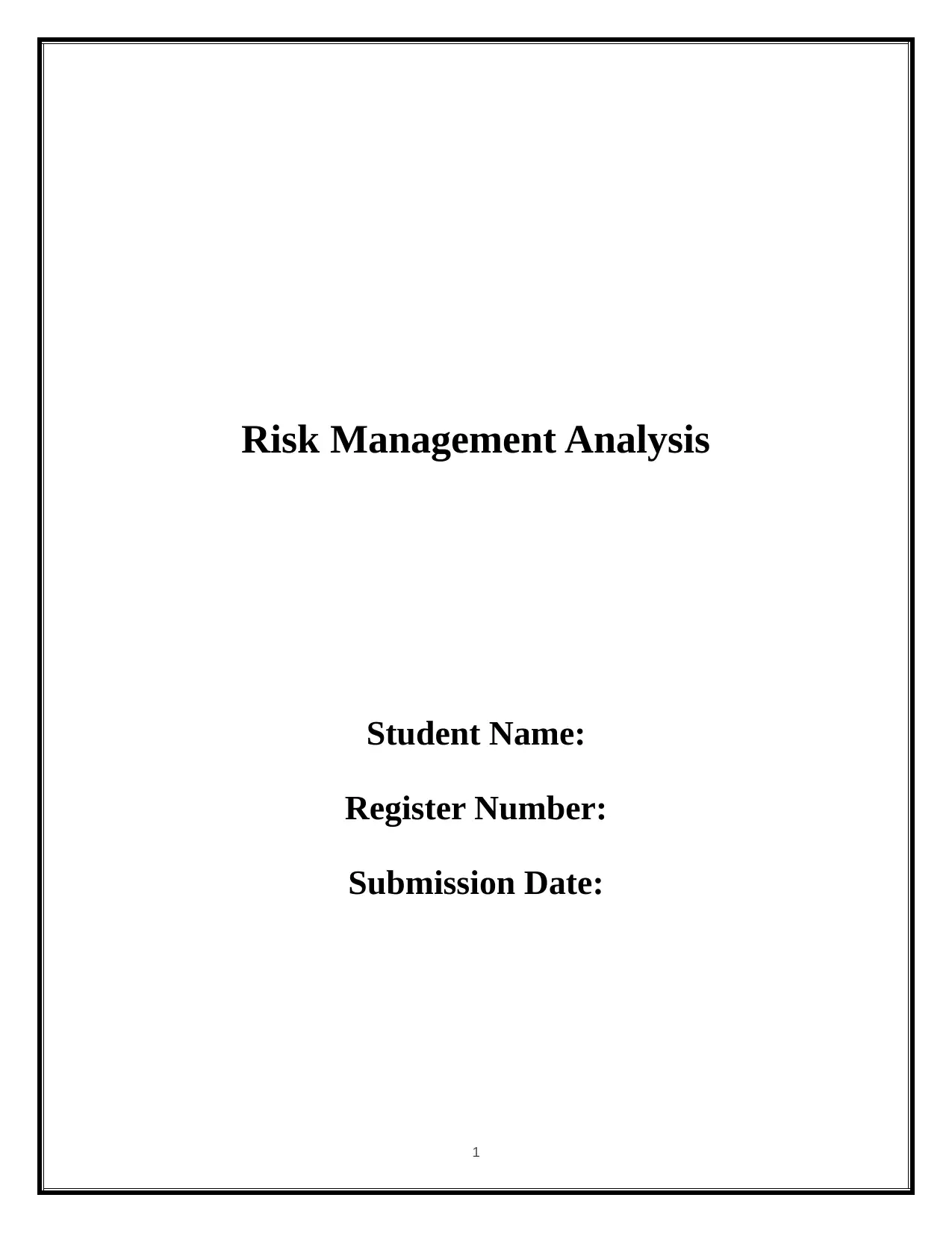
Risk Management Analysis
Student Name:
Register Number:
Submission Date:
1
Student Name:
Register Number:
Submission Date:
1
Paraphrase This Document
Need a fresh take? Get an instant paraphrase of this document with our AI Paraphraser
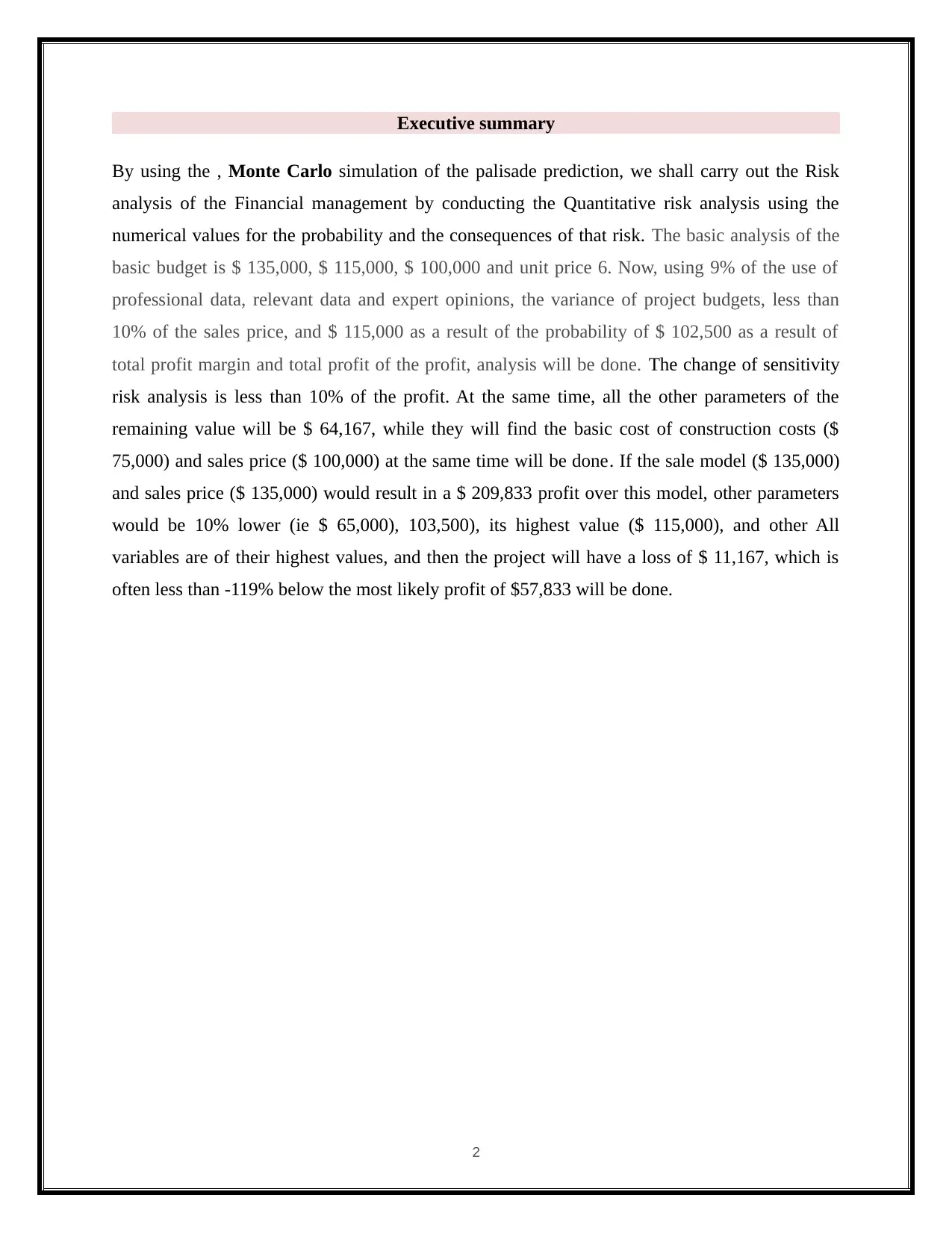
Executive summary
By using the , Monte Carlo simulation of the palisade prediction, we shall carry out the Risk
analysis of the Financial management by conducting the Quantitative risk analysis using the
numerical values for the probability and the consequences of that risk. The basic analysis of the
basic budget is $ 135,000, $ 115,000, $ 100,000 and unit price 6. Now, using 9% of the use of
professional data, relevant data and expert opinions, the variance of project budgets, less than
10% of the sales price, and $ 115,000 as a result of the probability of $ 102,500 as a result of
total profit margin and total profit of the profit, analysis will be done. The change of sensitivity
risk analysis is less than 10% of the profit. At the same time, all the other parameters of the
remaining value will be $ 64,167, while they will find the basic cost of construction costs ($
75,000) and sales price ($ 100,000) at the same time will be done. If the sale model ($ 135,000)
and sales price ($ 135,000) would result in a $ 209,833 profit over this model, other parameters
would be 10% lower (ie $ 65,000), 103,500), its highest value ($ 115,000), and other All
variables are of their highest values, and then the project will have a loss of $ 11,167, which is
often less than -119% below the most likely profit of $57,833 will be done.
2
By using the , Monte Carlo simulation of the palisade prediction, we shall carry out the Risk
analysis of the Financial management by conducting the Quantitative risk analysis using the
numerical values for the probability and the consequences of that risk. The basic analysis of the
basic budget is $ 135,000, $ 115,000, $ 100,000 and unit price 6. Now, using 9% of the use of
professional data, relevant data and expert opinions, the variance of project budgets, less than
10% of the sales price, and $ 115,000 as a result of the probability of $ 102,500 as a result of
total profit margin and total profit of the profit, analysis will be done. The change of sensitivity
risk analysis is less than 10% of the profit. At the same time, all the other parameters of the
remaining value will be $ 64,167, while they will find the basic cost of construction costs ($
75,000) and sales price ($ 100,000) at the same time will be done. If the sale model ($ 135,000)
and sales price ($ 135,000) would result in a $ 209,833 profit over this model, other parameters
would be 10% lower (ie $ 65,000), 103,500), its highest value ($ 115,000), and other All
variables are of their highest values, and then the project will have a loss of $ 11,167, which is
often less than -119% below the most likely profit of $57,833 will be done.
2
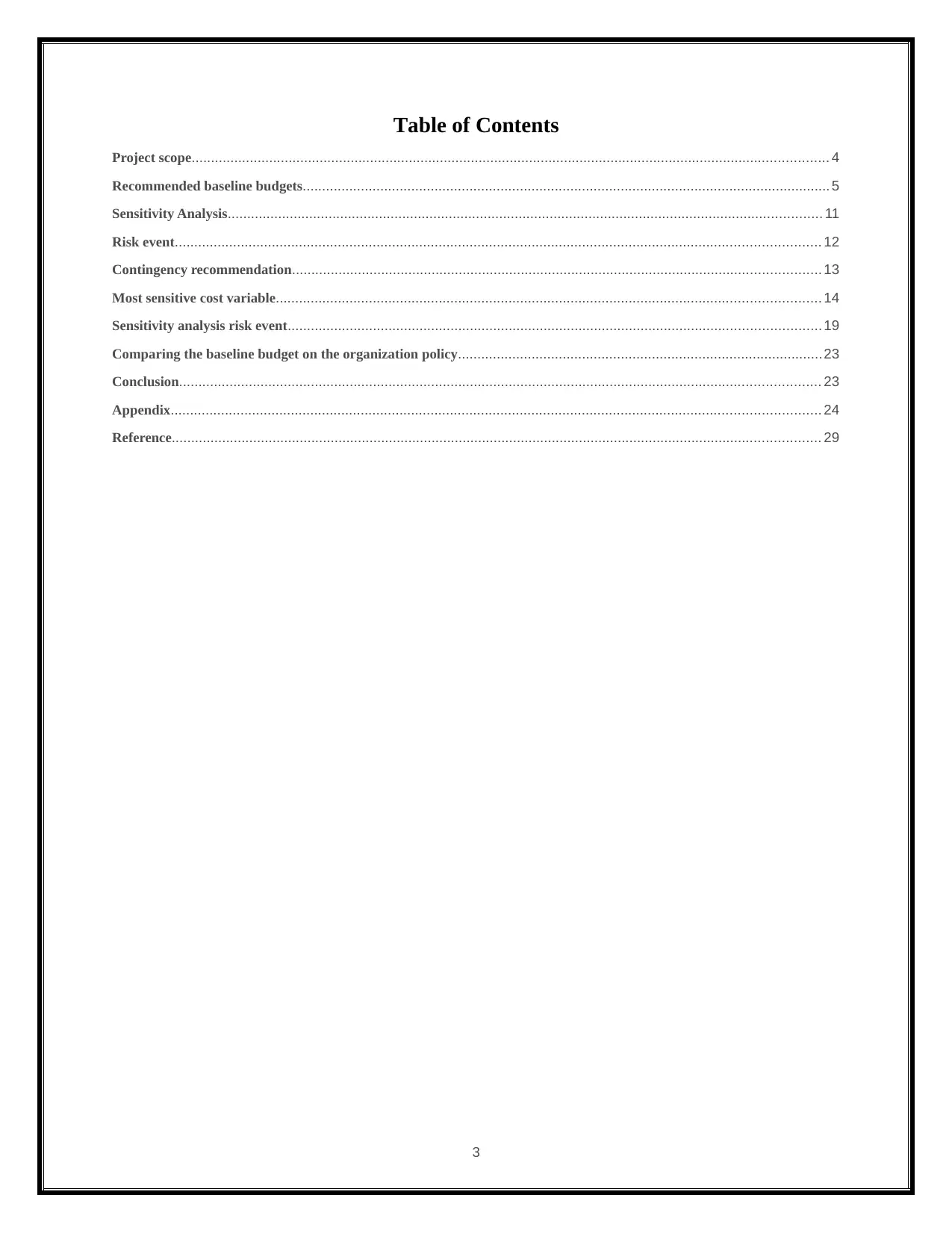
Table of Contents
Project scope.................................................................................................................................................................... 4
Recommended baseline budgets........................................................................................................................................ 5
Sensitivity Analysis......................................................................................................................................................... 11
Risk event...................................................................................................................................................................... 12
Contingency recommendation........................................................................................................................................ 13
Most sensitive cost variable............................................................................................................................................ 14
Sensitivity analysis risk event......................................................................................................................................... 19
Comparing the baseline budget on the organization policy..............................................................................................23
Conclusion..................................................................................................................................................................... 23
Appendix....................................................................................................................................................................... 24
Reference....................................................................................................................................................................... 29
3
Project scope.................................................................................................................................................................... 4
Recommended baseline budgets........................................................................................................................................ 5
Sensitivity Analysis......................................................................................................................................................... 11
Risk event...................................................................................................................................................................... 12
Contingency recommendation........................................................................................................................................ 13
Most sensitive cost variable............................................................................................................................................ 14
Sensitivity analysis risk event......................................................................................................................................... 19
Comparing the baseline budget on the organization policy..............................................................................................23
Conclusion..................................................................................................................................................................... 23
Appendix....................................................................................................................................................................... 24
Reference....................................................................................................................................................................... 29
3
⊘ This is a preview!⊘
Do you want full access?
Subscribe today to unlock all pages.

Trusted by 1+ million students worldwide
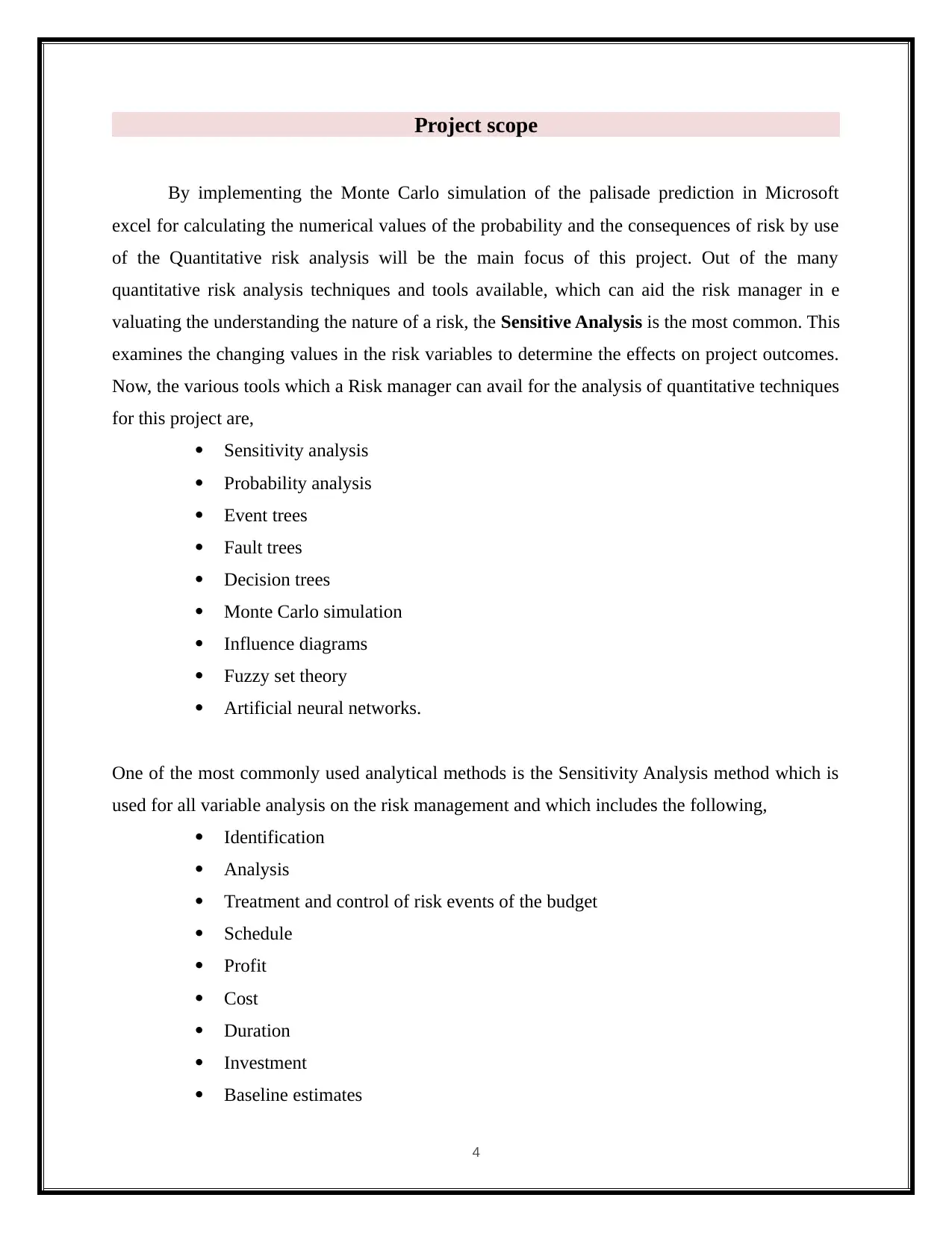
Project scope
By implementing the Monte Carlo simulation of the palisade prediction in Microsoft
excel for calculating the numerical values of the probability and the consequences of risk by use
of the Quantitative risk analysis will be the main focus of this project. Out of the many
quantitative risk analysis techniques and tools available, which can aid the risk manager in e
valuating the understanding the nature of a risk, the Sensitive Analysis is the most common. This
examines the changing values in the risk variables to determine the effects on project outcomes.
Now, the various tools which a Risk manager can avail for the analysis of quantitative techniques
for this project are,
Sensitivity analysis
Probability analysis
Event trees
Fault trees
Decision trees
Monte Carlo simulation
Influence diagrams
Fuzzy set theory
Artificial neural networks.
One of the most commonly used analytical methods is the Sensitivity Analysis method which is
used for all variable analysis on the risk management and which includes the following,
Identification
Analysis
Treatment and control of risk events of the budget
Schedule
Profit
Cost
Duration
Investment
Baseline estimates
4
By implementing the Monte Carlo simulation of the palisade prediction in Microsoft
excel for calculating the numerical values of the probability and the consequences of risk by use
of the Quantitative risk analysis will be the main focus of this project. Out of the many
quantitative risk analysis techniques and tools available, which can aid the risk manager in e
valuating the understanding the nature of a risk, the Sensitive Analysis is the most common. This
examines the changing values in the risk variables to determine the effects on project outcomes.
Now, the various tools which a Risk manager can avail for the analysis of quantitative techniques
for this project are,
Sensitivity analysis
Probability analysis
Event trees
Fault trees
Decision trees
Monte Carlo simulation
Influence diagrams
Fuzzy set theory
Artificial neural networks.
One of the most commonly used analytical methods is the Sensitivity Analysis method which is
used for all variable analysis on the risk management and which includes the following,
Identification
Analysis
Treatment and control of risk events of the budget
Schedule
Profit
Cost
Duration
Investment
Baseline estimates
4
Paraphrase This Document
Need a fresh take? Get an instant paraphrase of this document with our AI Paraphraser
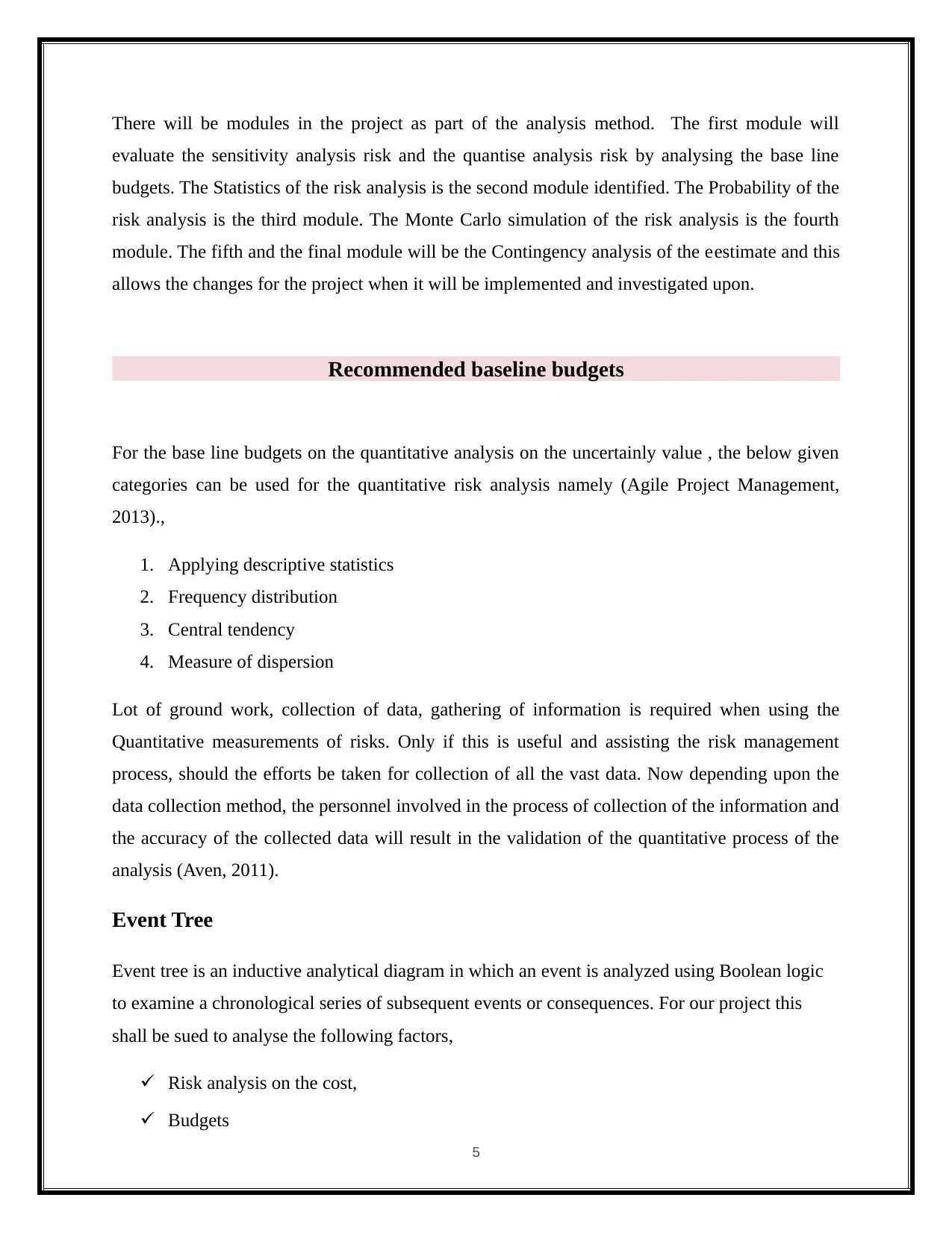
There will be modules in the project as part of the analysis method. The first module will
evaluate the sensitivity analysis risk and the quantise analysis risk by analysing the base line
budgets. The Statistics of the risk analysis is the second module identified. The Probability of the
risk analysis is the third module. The Monte Carlo simulation of the risk analysis is the fourth
module. The fifth and the final module will be the Contingency analysis of the eestimate and this
allows the changes for the project when it will be implemented and investigated upon.
Recommended baseline budgets
For the base line budgets on the quantitative analysis on the uncertainly value , the below given
categories can be used for the quantitative risk analysis namely (Agile Project Management,
2013).,
1. Applying descriptive statistics
2. Frequency distribution
3. Central tendency
4. Measure of dispersion
Lot of ground work, collection of data, gathering of information is required when using the
Quantitative measurements of risks. Only if this is useful and assisting the risk management
process, should the efforts be taken for collection of all the vast data. Now depending upon the
data collection method, the personnel involved in the process of collection of the information and
the accuracy of the collected data will result in the validation of the quantitative process of the
analysis (Aven, 2011).
Event Tree
Event tree is an inductive analytical diagram in which an event is analyzed using Boolean logic
to examine a chronological series of subsequent events or consequences. For our project this
shall be sued to analyse the following factors,
Risk analysis on the cost,
Budgets
5
evaluate the sensitivity analysis risk and the quantise analysis risk by analysing the base line
budgets. The Statistics of the risk analysis is the second module identified. The Probability of the
risk analysis is the third module. The Monte Carlo simulation of the risk analysis is the fourth
module. The fifth and the final module will be the Contingency analysis of the eestimate and this
allows the changes for the project when it will be implemented and investigated upon.
Recommended baseline budgets
For the base line budgets on the quantitative analysis on the uncertainly value , the below given
categories can be used for the quantitative risk analysis namely (Agile Project Management,
2013).,
1. Applying descriptive statistics
2. Frequency distribution
3. Central tendency
4. Measure of dispersion
Lot of ground work, collection of data, gathering of information is required when using the
Quantitative measurements of risks. Only if this is useful and assisting the risk management
process, should the efforts be taken for collection of all the vast data. Now depending upon the
data collection method, the personnel involved in the process of collection of the information and
the accuracy of the collected data will result in the validation of the quantitative process of the
analysis (Aven, 2011).
Event Tree
Event tree is an inductive analytical diagram in which an event is analyzed using Boolean logic
to examine a chronological series of subsequent events or consequences. For our project this
shall be sued to analyse the following factors,
Risk analysis on the cost,
Budgets
5
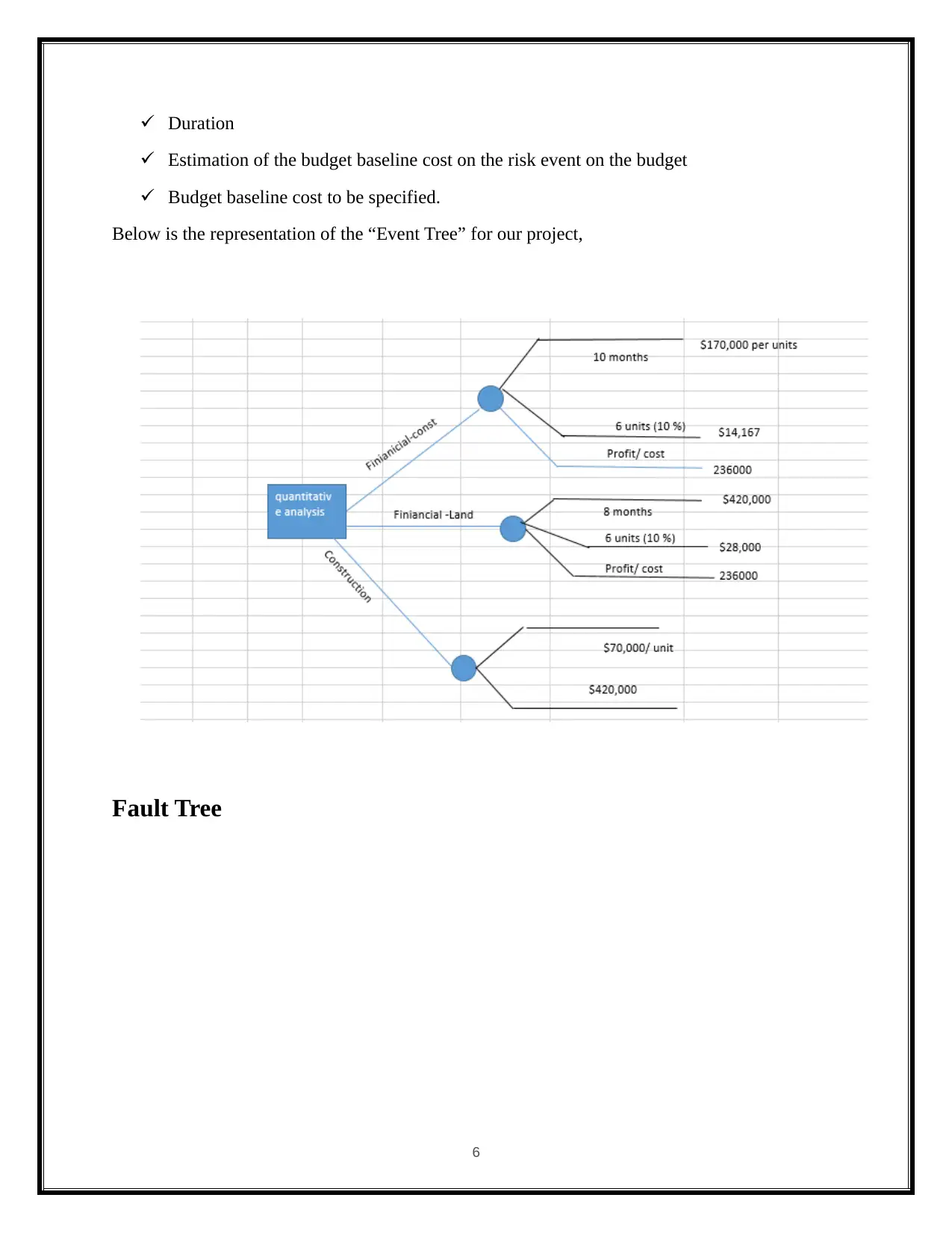
Duration
Estimation of the budget baseline cost on the risk event on the budget
Budget baseline cost to be specified.
Below is the representation of the “Event Tree” for our project,
Fault Tree
6
Estimation of the budget baseline cost on the risk event on the budget
Budget baseline cost to be specified.
Below is the representation of the “Event Tree” for our project,
Fault Tree
6
⊘ This is a preview!⊘
Do you want full access?
Subscribe today to unlock all pages.

Trusted by 1+ million students worldwide
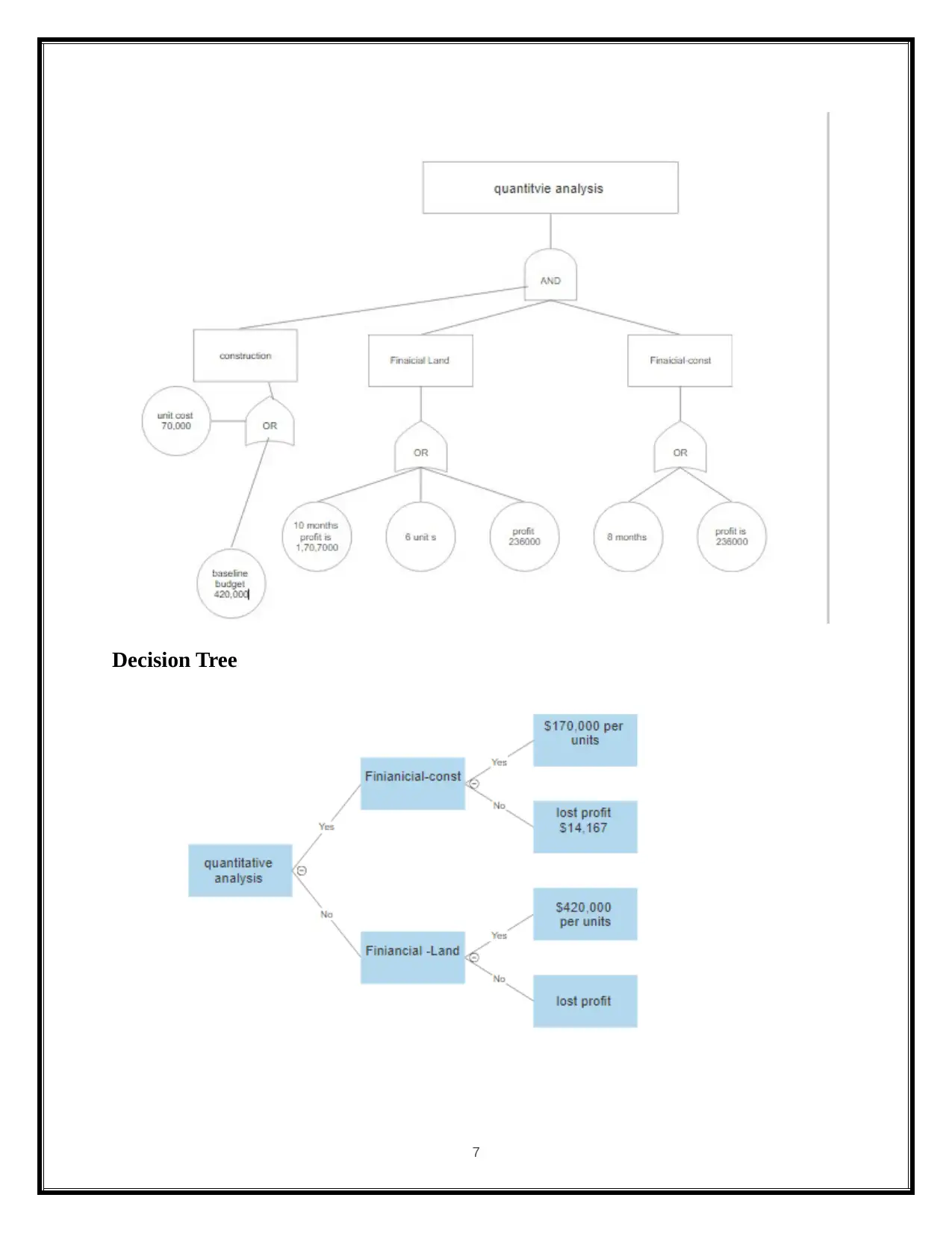
Decision Tree
7
7
Paraphrase This Document
Need a fresh take? Get an instant paraphrase of this document with our AI Paraphraser
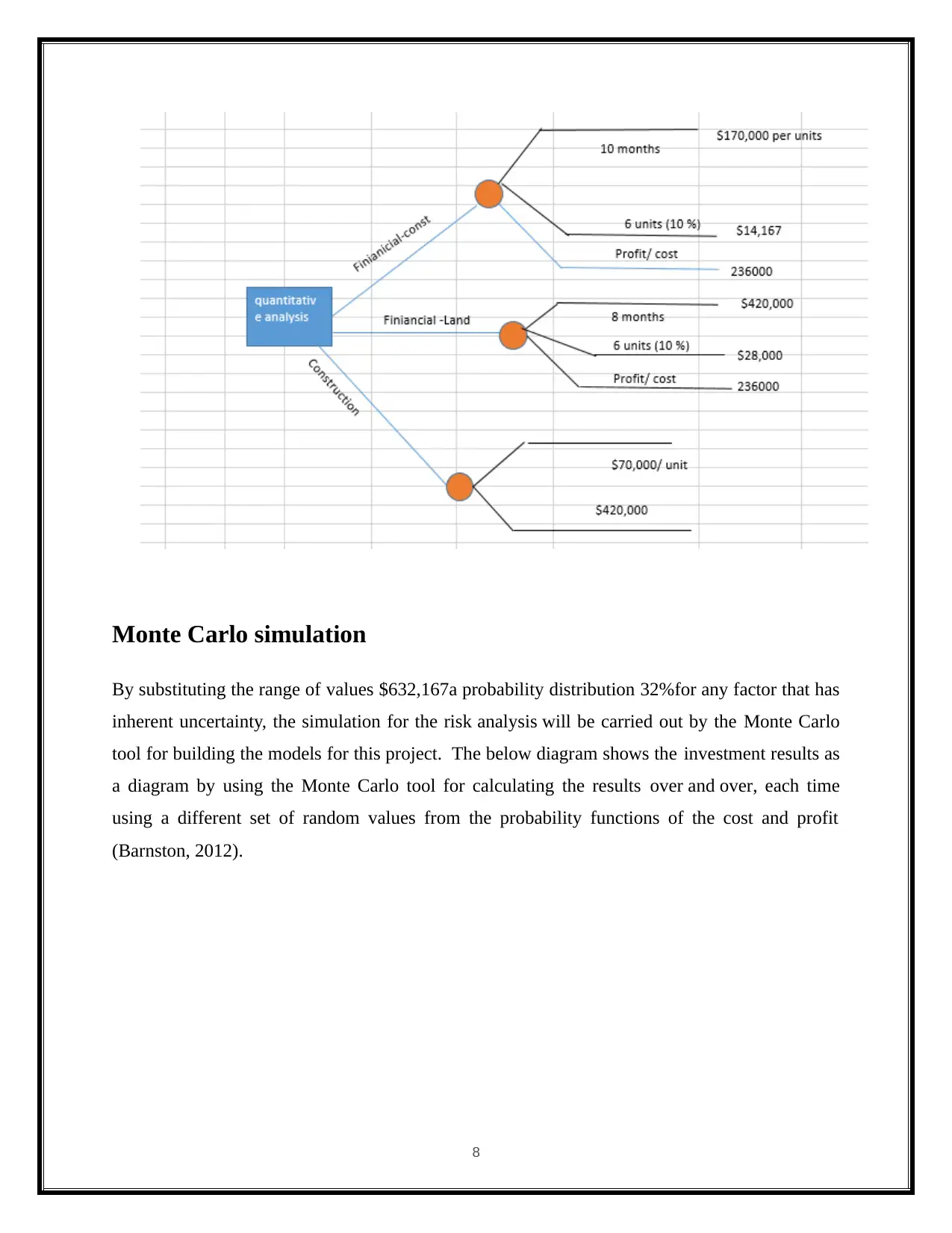
Monte Carlo simulation
By substituting the range of values $632,167a probability distribution 32%for any factor that has
inherent uncertainty, the simulation for the risk analysis will be carried out by the Monte Carlo
tool for building the models for this project. The below diagram shows the investment results as
a diagram by using the Monte Carlo tool for calculating the results over and over, each time
using a different set of random values from the probability functions of the cost and profit
(Barnston, 2012).
8
By substituting the range of values $632,167a probability distribution 32%for any factor that has
inherent uncertainty, the simulation for the risk analysis will be carried out by the Monte Carlo
tool for building the models for this project. The below diagram shows the investment results as
a diagram by using the Monte Carlo tool for calculating the results over and over, each time
using a different set of random values from the probability functions of the cost and profit
(Barnston, 2012).
8
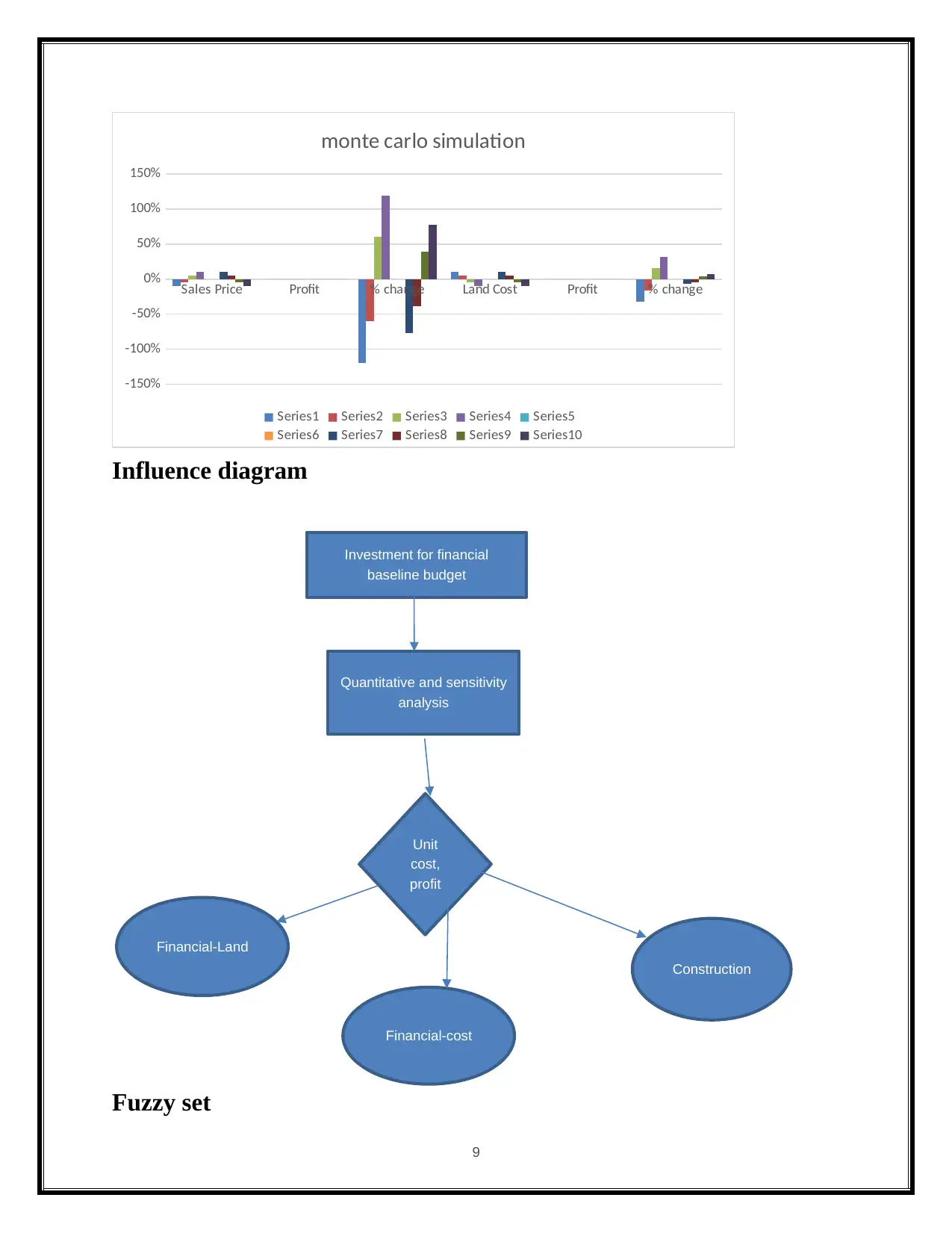
Sales Price Profit % change Land Cost Profit % change
-150%
-100%
-50%
0%
50%
100%
150%
monte carlo simulation
Series1 Series2 Series3 Series4 Series5
Series6 Series7 Series8 Series9 Series10
Influence diagram
Fuzzy set
9
Investment for financial
baseline budget
Quantitative and sensitivity
analysis
Unit
cost,
profit
Financial-Land
Financial-cost
Construction
-150%
-100%
-50%
0%
50%
100%
150%
monte carlo simulation
Series1 Series2 Series3 Series4 Series5
Series6 Series7 Series8 Series9 Series10
Influence diagram
Fuzzy set
9
Investment for financial
baseline budget
Quantitative and sensitivity
analysis
Unit
cost,
profit
Financial-Land
Financial-cost
Construction
⊘ This is a preview!⊘
Do you want full access?
Subscribe today to unlock all pages.

Trusted by 1+ million students worldwide
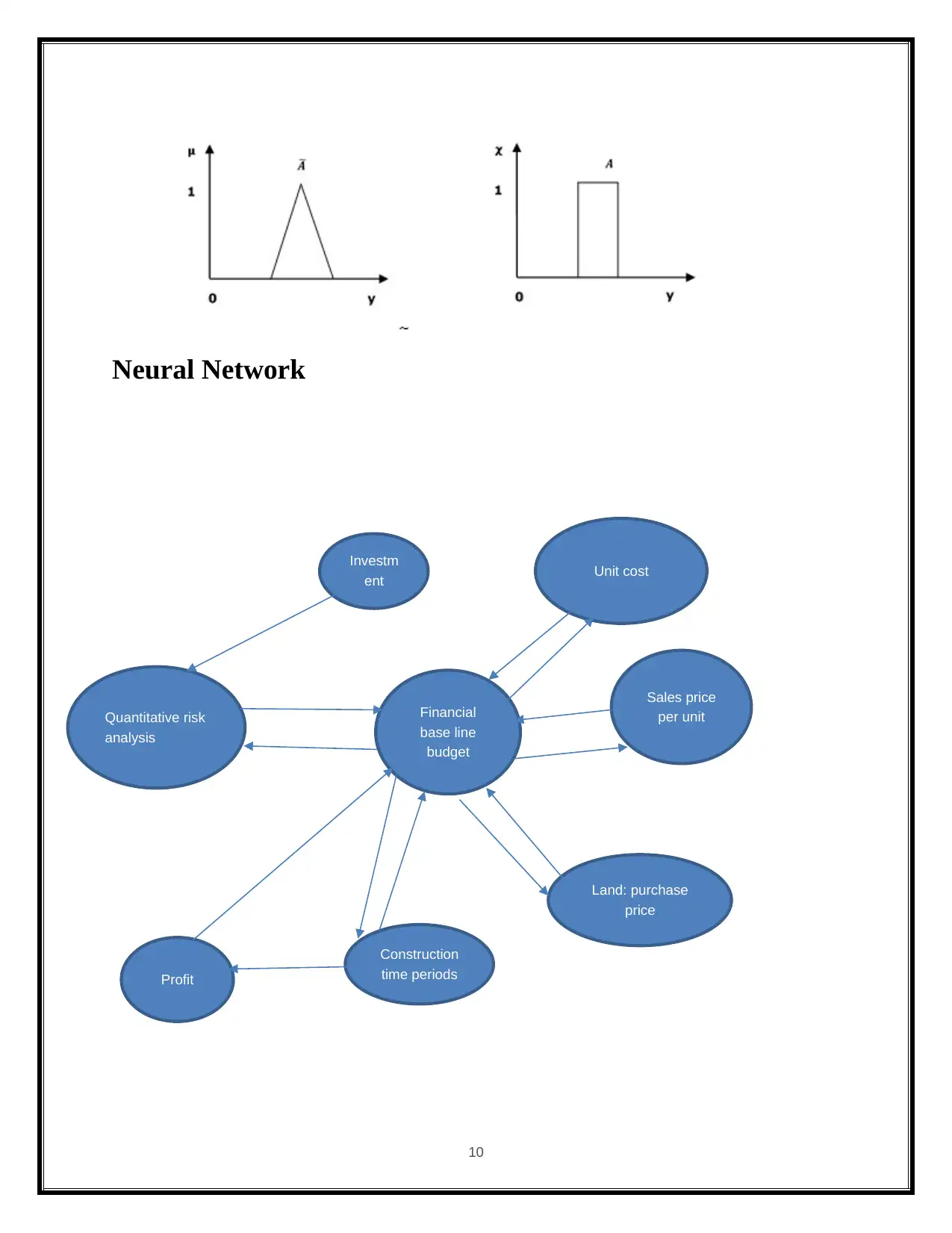
Neural Network
10
Quantitative risk
analysis
Unit cost
Sales price
per unit
Land: purchase
price
Financial
base line
budget
Construction
time periods
Investm
ent
Profit
10
Quantitative risk
analysis
Unit cost
Sales price
per unit
Land: purchase
price
Financial
base line
budget
Construction
time periods
Investm
ent
Profit
Paraphrase This Document
Need a fresh take? Get an instant paraphrase of this document with our AI Paraphraser
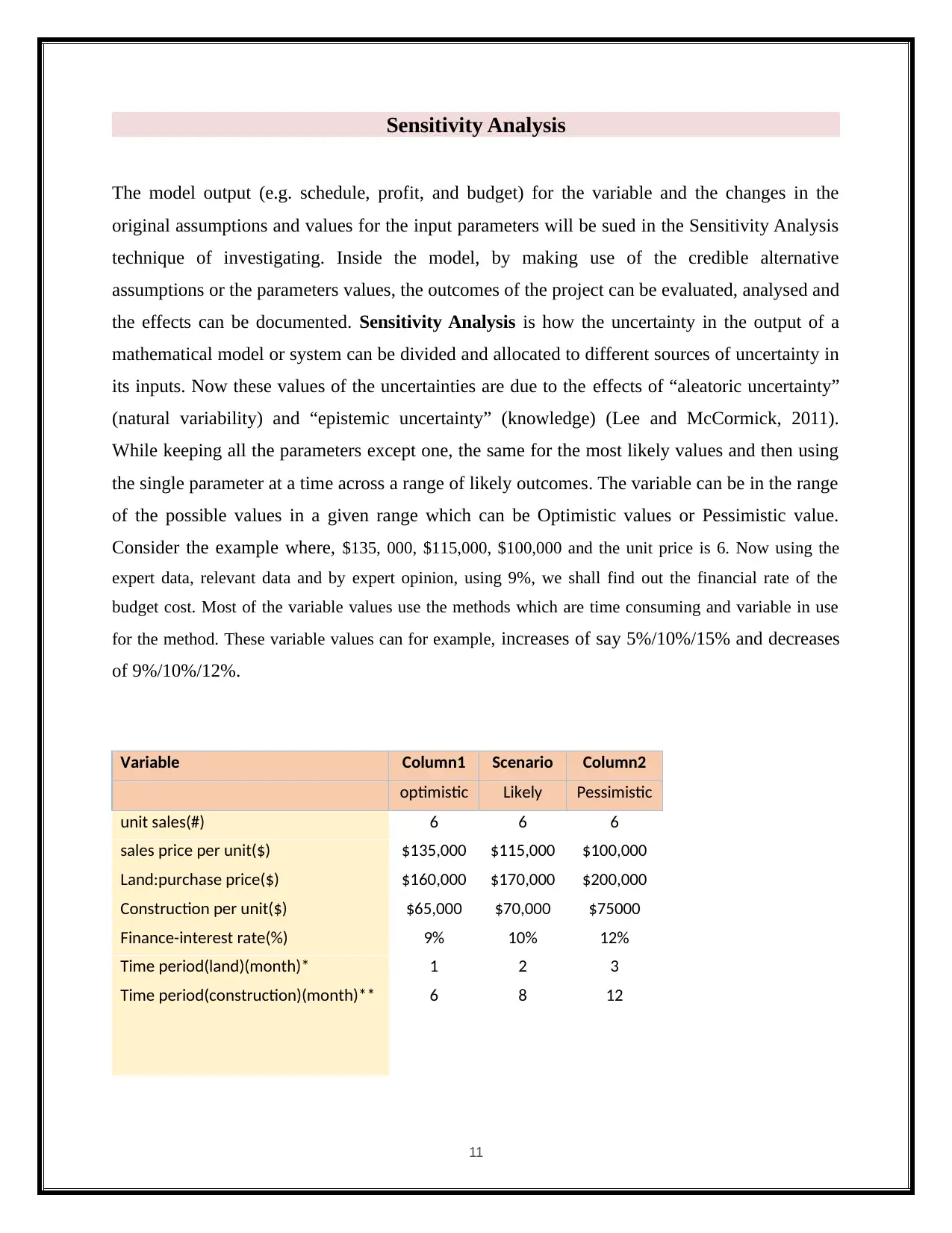
Sensitivity Analysis
The model output (e.g. schedule, profit, and budget) for the variable and the changes in the
original assumptions and values for the input parameters will be sued in the Sensitivity Analysis
technique of investigating. Inside the model, by making use of the credible alternative
assumptions or the parameters values, the outcomes of the project can be evaluated, analysed and
the effects can be documented. Sensitivity Analysis is how the uncertainty in the output of a
mathematical model or system can be divided and allocated to different sources of uncertainty in
its inputs. Now these values of the uncertainties are due to the effects of “aleatoric uncertainty”
(natural variability) and “epistemic uncertainty” (knowledge) (Lee and McCormick, 2011).
While keeping all the parameters except one, the same for the most likely values and then using
the single parameter at a time across a range of likely outcomes. The variable can be in the range
of the possible values in a given range which can be Optimistic values or Pessimistic value.
Consider the example where, $135, 000, $115,000, $100,000 and the unit price is 6. Now using the
expert data, relevant data and by expert opinion, using 9%, we shall find out the financial rate of the
budget cost. Most of the variable values use the methods which are time consuming and variable in use
for the method. These variable values can for example, increases of say 5%/10%/15% and decreases
of 9%/10%/12%.
Variable Column1 Scenario Column2
optimistic Likely Pessimistic
unit sales(#) 6 6 6
sales price per unit($) $135,000 $115,000 $100,000
Land:purchase price($) $160,000 $170,000 $200,000
Construction per unit($) $65,000 $70,000 $75000
Finance-interest rate(%) 9% 10% 12%
Time period(land)(month)* 1 2 3
Time period(construction)(month)** 6 8 12
11
The model output (e.g. schedule, profit, and budget) for the variable and the changes in the
original assumptions and values for the input parameters will be sued in the Sensitivity Analysis
technique of investigating. Inside the model, by making use of the credible alternative
assumptions or the parameters values, the outcomes of the project can be evaluated, analysed and
the effects can be documented. Sensitivity Analysis is how the uncertainty in the output of a
mathematical model or system can be divided and allocated to different sources of uncertainty in
its inputs. Now these values of the uncertainties are due to the effects of “aleatoric uncertainty”
(natural variability) and “epistemic uncertainty” (knowledge) (Lee and McCormick, 2011).
While keeping all the parameters except one, the same for the most likely values and then using
the single parameter at a time across a range of likely outcomes. The variable can be in the range
of the possible values in a given range which can be Optimistic values or Pessimistic value.
Consider the example where, $135, 000, $115,000, $100,000 and the unit price is 6. Now using the
expert data, relevant data and by expert opinion, using 9%, we shall find out the financial rate of the
budget cost. Most of the variable values use the methods which are time consuming and variable in use
for the method. These variable values can for example, increases of say 5%/10%/15% and decreases
of 9%/10%/12%.
Variable Column1 Scenario Column2
optimistic Likely Pessimistic
unit sales(#) 6 6 6
sales price per unit($) $135,000 $115,000 $100,000
Land:purchase price($) $160,000 $170,000 $200,000
Construction per unit($) $65,000 $70,000 $75000
Finance-interest rate(%) 9% 10% 12%
Time period(land)(month)* 1 2 3
Time period(construction)(month)** 6 8 12
11
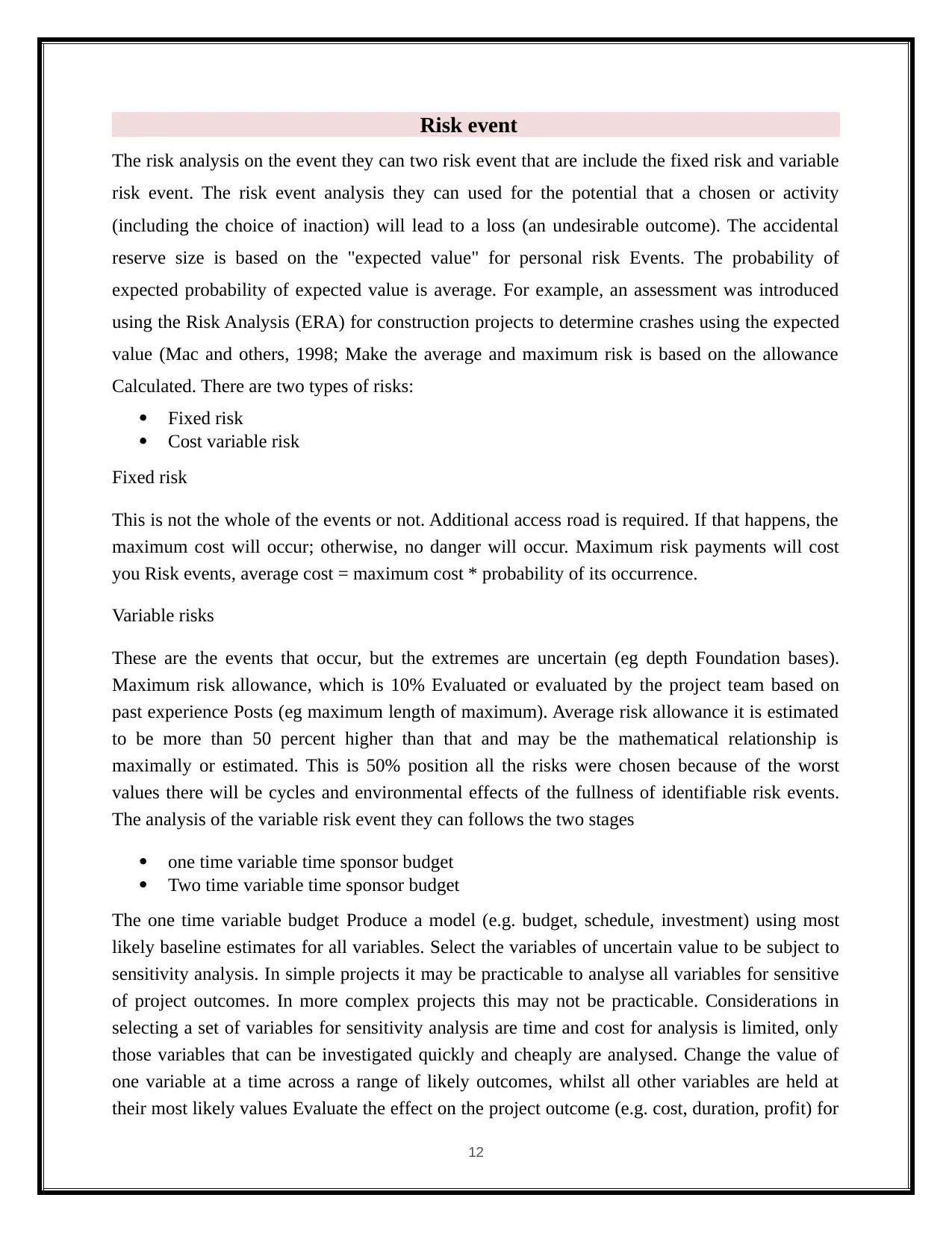
Risk event
The risk analysis on the event they can two risk event that are include the fixed risk and variable
risk event. The risk event analysis they can used for the potential that a chosen or activity
(including the choice of inaction) will lead to a loss (an undesirable outcome). The accidental
reserve size is based on the "expected value" for personal risk Events. The probability of
expected probability of expected value is average. For example, an assessment was introduced
using the Risk Analysis (ERA) for construction projects to determine crashes using the expected
value (Mac and others, 1998; Make the average and maximum risk is based on the allowance
Calculated. There are two types of risks:
Fixed risk
Cost variable risk
Fixed risk
This is not the whole of the events or not. Additional access road is required. If that happens, the
maximum cost will occur; otherwise, no danger will occur. Maximum risk payments will cost
you Risk events, average cost = maximum cost * probability of its occurrence.
Variable risks
These are the events that occur, but the extremes are uncertain (eg depth Foundation bases).
Maximum risk allowance, which is 10% Evaluated or evaluated by the project team based on
past experience Posts (eg maximum length of maximum). Average risk allowance it is estimated
to be more than 50 percent higher than that and may be the mathematical relationship is
maximally or estimated. This is 50% position all the risks were chosen because of the worst
values there will be cycles and environmental effects of the fullness of identifiable risk events.
The analysis of the variable risk event they can follows the two stages
one time variable time sponsor budget
Two time variable time sponsor budget
The one time variable budget Produce a model (e.g. budget, schedule, investment) using most
likely baseline estimates for all variables. Select the variables of uncertain value to be subject to
sensitivity analysis. In simple projects it may be practicable to analyse all variables for sensitive
of project outcomes. In more complex projects this may not be practicable. Considerations in
selecting a set of variables for sensitivity analysis are time and cost for analysis is limited, only
those variables that can be investigated quickly and cheaply are analysed. Change the value of
one variable at a time across a range of likely outcomes, whilst all other variables are held at
their most likely values Evaluate the effect on the project outcome (e.g. cost, duration, profit) for
12
The risk analysis on the event they can two risk event that are include the fixed risk and variable
risk event. The risk event analysis they can used for the potential that a chosen or activity
(including the choice of inaction) will lead to a loss (an undesirable outcome). The accidental
reserve size is based on the "expected value" for personal risk Events. The probability of
expected probability of expected value is average. For example, an assessment was introduced
using the Risk Analysis (ERA) for construction projects to determine crashes using the expected
value (Mac and others, 1998; Make the average and maximum risk is based on the allowance
Calculated. There are two types of risks:
Fixed risk
Cost variable risk
Fixed risk
This is not the whole of the events or not. Additional access road is required. If that happens, the
maximum cost will occur; otherwise, no danger will occur. Maximum risk payments will cost
you Risk events, average cost = maximum cost * probability of its occurrence.
Variable risks
These are the events that occur, but the extremes are uncertain (eg depth Foundation bases).
Maximum risk allowance, which is 10% Evaluated or evaluated by the project team based on
past experience Posts (eg maximum length of maximum). Average risk allowance it is estimated
to be more than 50 percent higher than that and may be the mathematical relationship is
maximally or estimated. This is 50% position all the risks were chosen because of the worst
values there will be cycles and environmental effects of the fullness of identifiable risk events.
The analysis of the variable risk event they can follows the two stages
one time variable time sponsor budget
Two time variable time sponsor budget
The one time variable budget Produce a model (e.g. budget, schedule, investment) using most
likely baseline estimates for all variables. Select the variables of uncertain value to be subject to
sensitivity analysis. In simple projects it may be practicable to analyse all variables for sensitive
of project outcomes. In more complex projects this may not be practicable. Considerations in
selecting a set of variables for sensitivity analysis are time and cost for analysis is limited, only
those variables that can be investigated quickly and cheaply are analysed. Change the value of
one variable at a time across a range of likely outcomes, whilst all other variables are held at
their most likely values Evaluate the effect on the project outcome (e.g. cost, duration, profit) for
12
⊘ This is a preview!⊘
Do you want full access?
Subscribe today to unlock all pages.

Trusted by 1+ million students worldwide
1 out of 31
Related Documents
Your All-in-One AI-Powered Toolkit for Academic Success.
+13062052269
info@desklib.com
Available 24*7 on WhatsApp / Email
![[object Object]](/_next/static/media/star-bottom.7253800d.svg)
Unlock your academic potential
Copyright © 2020–2025 A2Z Services. All Rights Reserved. Developed and managed by ZUCOL.





